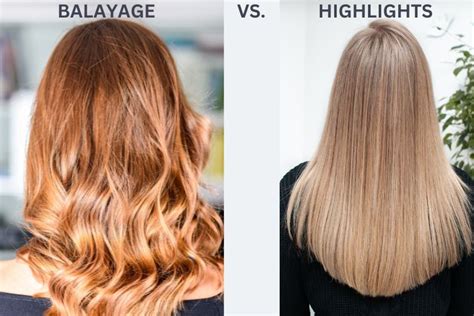1. Application Technique
- Highlights: Involve selectively bleaching strands of hair using a highlighting cap or foils.
- Balayage: A freehand painting technique where bleach is applied to create a gradual gradation of color.
2. Resulting Effect
- Highlights: Create a bold, contrasting effect with clearly defined streaks of lighter hair.
- Balayage: Produces a more natural, blended look with subtle transitions of color, resembling sun-kissed hair.
3. Maintenance Requirements
- Highlights: Require regular touch-ups to maintain contrast, typically every 6-8 weeks.
- Balayage: Requires less frequent maintenance, with touch-ups only needed every 12-16 weeks.
Additional Key Points
- Cost: Highlights tend to be more expensive than balayage due to the more labor-intensive application process.
- Damage: Both techniques involve bleaching, which can damage hair. Balayage may be slightly less damaging, as it does not require foils or bleach to be applied directly to the roots.
- Customization: Balayage allows for more customization in terms of color placement and gradation, resulting in a unique look for each client.
- Popularity: Balayage has become increasingly popular in recent years due to its natural-looking results and low maintenance requirements.
How to Choose Between Highlights and Balayage
The best choice for you depends on your desired effect, lifestyle, and hair type.

- For a bold, contrasting look with high maintenance, highlights are the way to go.
- For a more natural, blended appearance with lower maintenance, balayage is a better option.
Step-by-Step Instructions for Balayage
- Prep your hair: Wash and dry your hair. Use a detangling spray to prevent breakage.
- Section your hair: Divide your hair into four quadrants. Tie each quadrant up with a hair tie.
- Apply bleach: Using a balayage brush, apply bleach to small sections of hair at an angle. Start from the mid-lengths and blend towards the ends.
- Develop: Allow the bleach to develop according to the manufacturer’s instructions.
- Tone: Once the bleach has developed, apply a toner to neutralize any unwanted brassiness.
- Rinse and style: Rinse your hair thoroughly and style as desired.
Pros and Cons of Highlights and Balayage
Highlights
Pros:
* Bold, contrasting effect
* Can be customized to create different looks
* Long-lasting results
Cons:
* High maintenance
* Can be damaging to hair
* Expensive
Balayage
Pros:
* Natural-looking, blended result
* Low maintenance
* Less damaging to hair
Cons:
* Can be more expensive than highlights
* Not suitable for all hair types
* May not be as versatile as highlights
